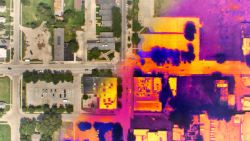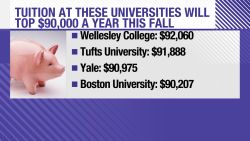Life has moved online during the coronavirus pandemic, and access to the internet has shone a new light on America’s inequality crisis.
Nearly 15% of American households do not have a home internet subscription, including dial-up, broadband or a cellular data plan, according to US Census estimates from 2018. For low-income earners, that percentage is more than double the national average.
A Pew Research study published last June discovered a link between household income and home broadband services, as well as access disparities between people of different races and education levels.
Lower-income Americans without internet access can often find it at their offices, schools and libraries. But those have been shuttered during the pandemic. Many people are struggling to get online, including children attending school virtually and people who want to access their state’s unemployment filing system online.
House Democrats on Tuesday unveiled their latest Covid-19 stimulus bill, which includes $5.5 billion to help expand home internet access, a move experts say is key to mitigating the immediate accessibility issues. However, the provision in the bill probably won’t be a long term fix, which is needed as coronavirus accelerates schools’ and companies’ shifts to digital.
“It took this pandemic for people to realize that tens of millions of people don’t have [an] internet connection,” said Gigi Sohn, distinguished fellow at the Georgetown Law Institute for Technology Law and Policy and former senior staffer at the Federal Communications Commission.
Experts say further investments in internet infrastructure and federal funding programs are needed to change the structural failures that created the current inequality.
The pandemic is an opportunity for policymakers and the industry to push longer-term fixes, said Jonathan Spalter, CEO of industry trade group USTelecom.
“I don’t think there’s ever been a time where all parties, all political perspectives, have been so aligned in understanding the truly critical role that broadband is playing for all Americans today,” Spalter said.
Barriers to access
A lack of home internet access is often thought of as a rural issue, but in urban areas where home internet services are readily available, affordability is a barrier to access.
Many rural areas of the country simply do not have the infrastructure to support the kind of internet connectivity and speed needed for entire families to attend school or work. For internet providers there is less economic incentive to build out their network in those areas.
Lauren Ardizzone, a New York City public school teacher, said many of her students have limited access to devices and lack adequate internet connections to attend online classes, making it hard for her to teach during the pandemic.
“There is no low-tech option anymore,” she told CNN Business. “I can’t hold students accountable for learning things that I can’t teach them.”
New York City and New York’s Department of Education provide families in need with devices to help mitigate that challenge, while some telecom companies offer free internet access and have suspended data limits to help bridge the gap in access.
But across the country, students without such options have been forced to attend online classes from their school’s parking lots where they can connect to the Wi-Fi network or find other ways to access internet connectivity that they don’t have at home.
This disparity could further exacerbate unequal access to college for certain students.
The House Democrats’ new bill would provide help. The bill includes $1.5 billion for an FCC program called “E-Rate” which funds the distribution of Wi-Fi hotspots, connected devices and other connectivity equipment to schools and libraries. It also dictates that schools and libraries be able to distribute those products for students to use beyond school grounds, something that the FCC previously did not allow.
The House bill also includes $4 billion in funding for FCC’s “Lifeline” program, which provides low-income consumers with monthly subsidies for broadband internet access. If the bill is approved, that funding would be available for just over a year.
“The way K-12 education works in our country, if we go into a class of 30 kids, we don’t say, ‘Okay you 25, you get a book. You other five are on your own. If you can afford a book, great, but if you can’t you can come to our parking lot’,” Dean Brenner, senior vice president of spectrum strategy at Qualcomm (QCOM), said.
“Education is supposed to be universal in this country,” he added.
Expanding access
More sustainable solutions will be needed to ensure the United States is better prepared to weather the next potential disruption, experts say. One oft-proposed option is free nationwide Wi-Fi, or “universal Wi-Fi”.
But it’s not that simple in America, said Qualcomm’s Brenner. The technology underlying the network would cost money to install and maintain, he said, and “in a country with as many square miles as the United States, it’s just not practical.”
Industry experts say there are also physical hurdles to building the infrastructure required. The idea might also run up against issues with the private companies running America’s internet connectivity.
“That would be great, but I don’t know how that would ever politically survive,” Sohn said. “Super high-speed connectivity, free to every home in the United States? Not happening.”
The US government has tried many times to enhance internet adoption in urban areas and expand internet availability in rural locations. But those efforts have been met with a mix of red tape and practical hurdles. Satellite internet shows promise, but it is still a long way off from reality.
Still, there are other possible methods to address the issue.
For one, industry players say the FCC could funnel more money into the E-Rate and Lifeline programs. Every year there is around $1 billion in E-Rate funding that is not spent and rolled over by the FCC. That money could be used to expand the programs support for students and families in need, Brenner said.
The FCC could also expand who is eligible to receive subsidies for internet access through the Lifeline program. Americans on federal benefits programs such as SNAP and Medicaid are currently eligible for the program. This should be extended to people currently receiving unemployment benefits, Sohn said. More funding for the Lifeline program would also help keep up with the growing cost of internet subscriptions.
As a first step, USTelecom’s Spalter said America needs an improved mapping system, so there can be national consensus on where broadband networks are and aren’t available, and thus where resources to build out infrastructure should be directed.
“There’s been broad agreement that we must prioritize getting broadband to areas that are truly unserved,” Spalter said. “What we haven’t had are consistent and agreed upon perspectives on truly where broadband is and isn’t in our country … so dollars can be directed as quickly and efficiently as possible.”
Last month, lawmakers passed the Broadband Deployment Accuracy and Technological Availability Act, which is intended to improve data collection on broadband availability and create a modernized map. Spalter urged Congress to provide adequate funding to the effort underway quickly.




























